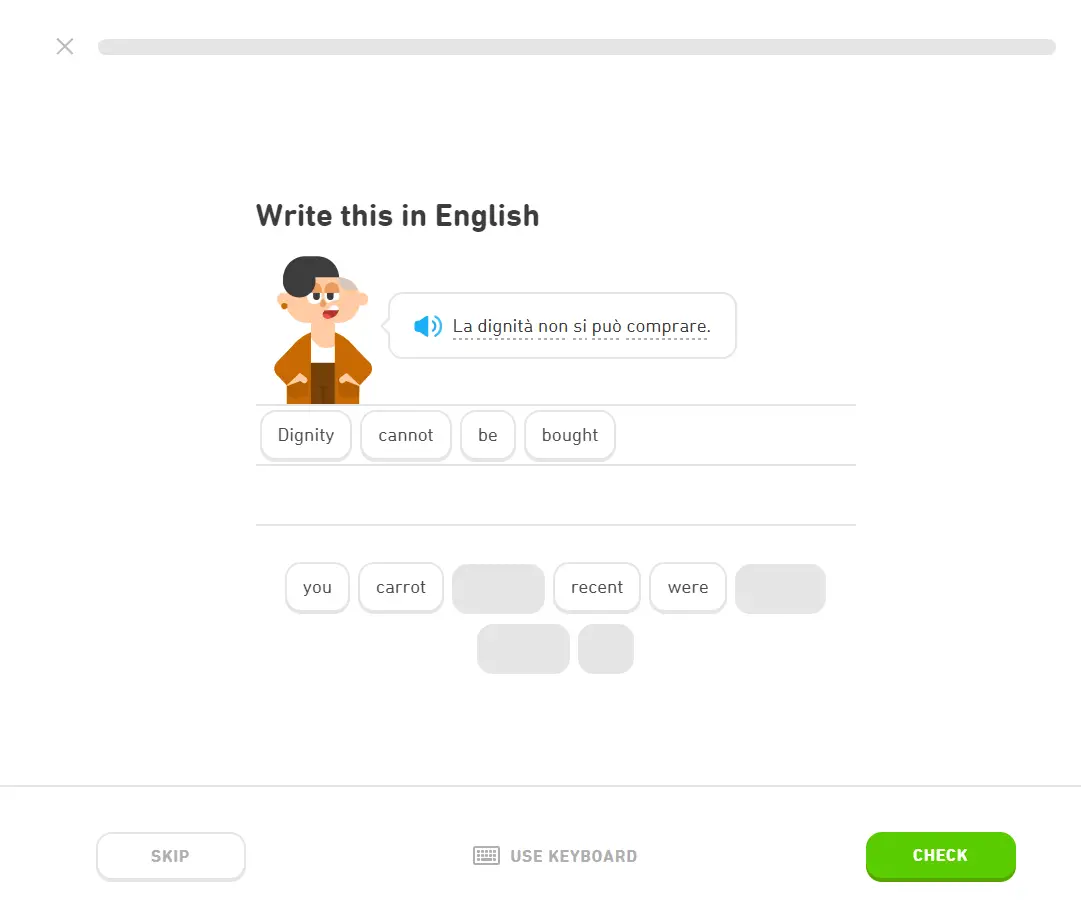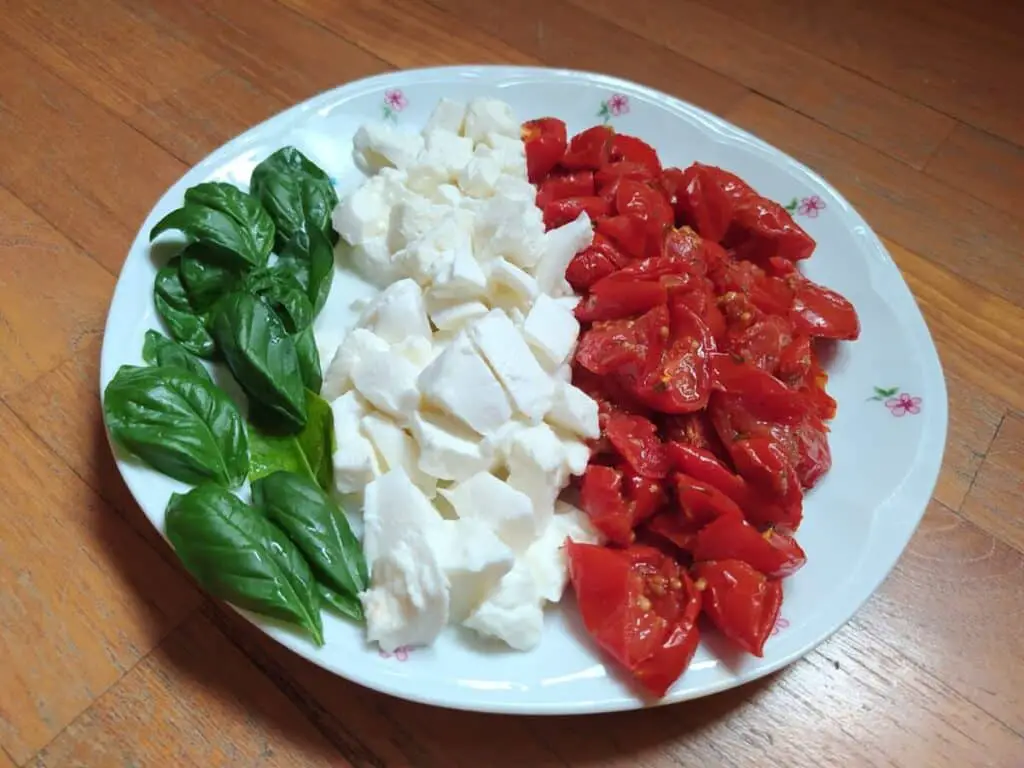If you are you considering the Italian course in Duolingo but are not sure if it is the right level for your Italian, then you are in the right place.
This article will detail what level of Italian each Duolingo section corresponds to, so you will get an understanding of what material the Duolingo Italian tree contains and how complex it is.
Keep reading to find out more!
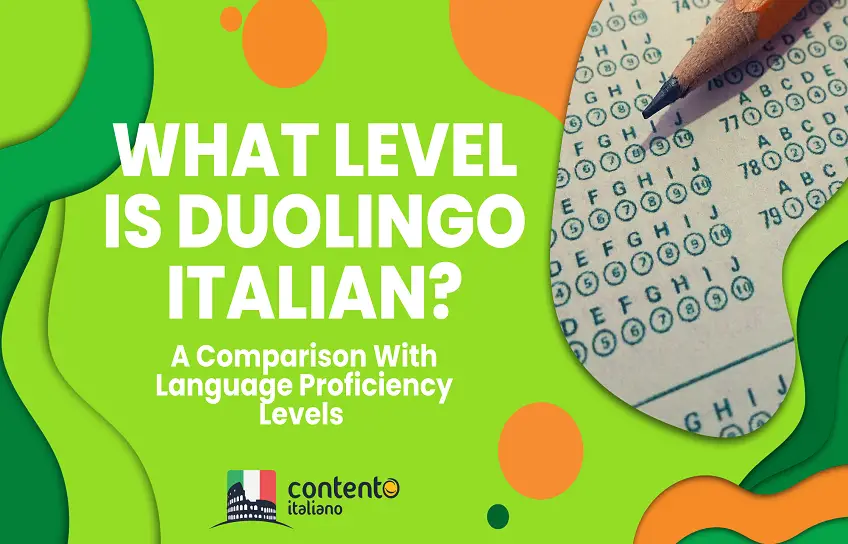
Table of Contents
- What level are the Duolingo Italian lessons?
- How does the Duolingo Italian course relate to language proficiency levels?
- How advanced is the Duolingo Italian course?
- Can the Duolingo Italian course make me proficient?
- Which Italian tenses will I learn in Duolingo Italian?
- Is the Duolingo Italian course suitable for beginners?
What level are the Duolingo Italian lessons?
Proficiency in a language is often classified according to the Common European Framework of Reference for Languages (CEFR). Within the framework, there are six levels of proficiency. These are:
- A1 Beginners
- A2 Elementary
- B1 Intermediate
- B2 Upper Intermediate
- C1 Advanced
- C2 Proficiency
The Duolingo Italian course is divided into four sections (click here to find out about number of lessons, crowns, skills, levels, etc…).
In the table below, we have summarized the contents of the Duolingo Italian lessons within each section of the Duolingo Italian tree. We have also related the level of each Duolingo section to the European Framework for language proficiency.
This should help you to gain an understanding of what each section of the Duolingo Italian course will cover and what level of language proficiency you could expect to achieve from it.
| DUOLINGO COURSE SECTION | VERB TENSES AND MOODS | OTHER GRAMMAR TOPICS | VOCABULARY TOPICS | DIFFICULTY AND CEFR LEVEL EQUIVALENT |
|---|---|---|---|---|
| SECTION 1 | – Present tense (e.g. I am a girl) | – Key phrases for greetings – Gender (masculine and feminine nouns) – Number (singular and plural nouns) – The definite article “the” and how it varies in gender and number – Possessive adjectives (e.g. this is my house) – Asking questions and using the question words which, where, what, how & when | – Food – Animals – Clothing | This Duolingo section provides very basic knowledge of Italian. Loosely comparable to CEFR A1 (beginners) |
| SECTION 2 | – Present tense (e.g. I cook). Conjugating different verbs – Present perfect (“passato prossimo” in Italian) (e.g. I didn’t go/ I haven’t been) – Infinitive mood (e.g. to stay/ staying/ to go/ going) – Imperative mood (e.g. find it!) | – Conjunctions (such as but, or & and) – The preposition to and how it blends with the to form compound prepositions – Gender and number agreement of adjectives – Use of adverbs (such as very, there & little) – Italian clitics (e.g. using the Italian “mi” for “to me”, “te” for “yourself”, “vi” for “to you”) – Demonstrative adjectives such as “this one”, “that one”, “these ones” – Indefinite pronouns (someone & the other) – The formal “you” | – Colours – Time – Family – Measure – Occupation – Household – Places – Objects – People – Numbers | This Duolingo section is packed with grammatical information, some of which is very complex (e.g. clitics). Loosely comparable to CEFR A2 / B1 (Elementary/ Intermediate) |
| SECTION 3 | – Imperfect tense (e.g. I used to cook) – Past perfect (“trapassato prossimo” in Italian) (e.g. I had cooked) – Future tense (e.g. I will cook) – Gerund mood (e.g. I am cooking) – Infinitive mood (part 2) (e.g. to stay/ staying/ to go/ going) | – Gender and number agreement of adjectives (part 2) – Use of adverbs (e.g. immediately) | – Education – Travel – Directions – Feelings – Abstract nouns (e.g. truth & freedom) – Sports – Medical | This Duolingo section contains some very complex tenses for a student at this level. Loosely comparable to CEFR B1 / B2 (Intermediate / Upper intermediate) |
SECTION 4 | – Future perfect (e.g. they will already have arrived) – Preterite past (e.g. they arrived) – Present subjunctive (e.g. I don’t know if she has arrived) – Conditional present (e.g. I would cook) – Conditional perfect (e.g. I would have cooked) – Subjunctive perfect (e.g. I didn’t know if she had arrived) | – Modal verbs. In Italian these are can, want and must (potere, volere, dovere) in all tenses | – Spiritual – Politics – Business – Arts – General conversation – Abstract nouns (part 2) (e.g. truth & freedom) | This Duolingo section contains some very complex tenses as well as use of complex verbs (modal verbs). Loosely comparable to CEFR B2 (Upper Intermediate), with some grammar topics at C1 level (Advanced) |
How does the Duolingo Italian course relate to language proficiency levels?
The contents of the Duolingo course can only be very loosely related to CEFR levels. This is because each of the CEFR levels for Italian (A1, A2, B1, B2, C1, C2) is very much focused on conversational aspects, such as being able to exchange information about a variety of matters with another person and being able to hold a conversation on both practical and abstract subjects.
On the other hand, due to being an app, Duolingo’s ability to teach conversational Italian is very limited.
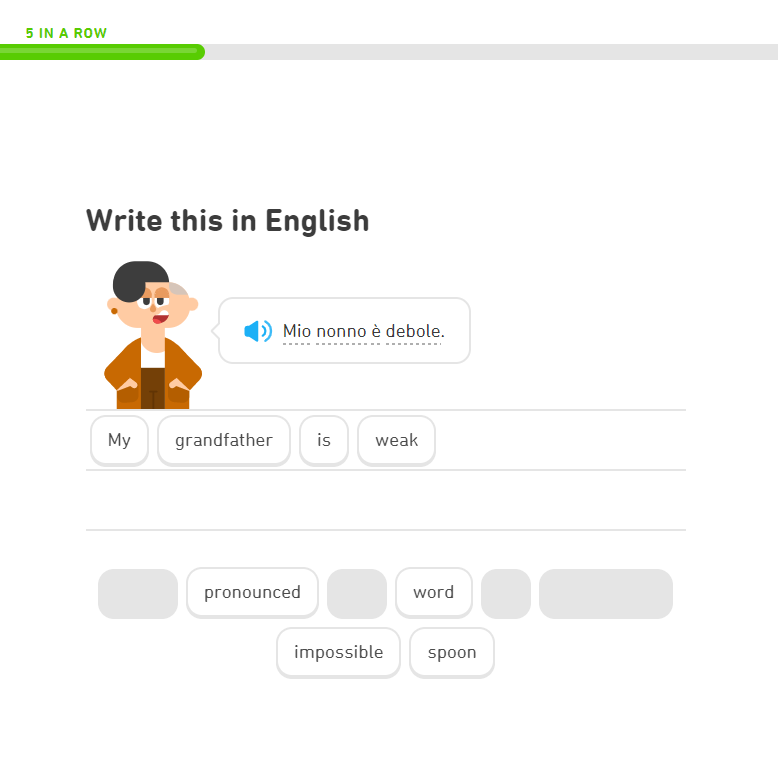
A scientific study found that the language proficiency gained by completing seven units of the French or Spanish courses in Duolingo was equivalent to four semesters of University study for reading and listening skills. Interestingly, the study was around reading and listening skills only, but did not focus on speaking skills.
Although the Italian Duolingo course covers a lot of material in a small number of sections, it is unlikely for a student to become fluent in Italian by using Duolingo alone.
How advanced is the Duolingo Italian course?
The Duolingo Italian course packs a lot of complex grammar topics within its four sections, and therefore could be considered to teach up to an advanced level in Italian. However, it is very unlikely that someone could become proficient in Italian by using Duolingo alone.
Here are two examples of very advanced topics:
- The subjunctive mood (present and perfect tense) (Duolingo section 4)
The subjunctive is an extremely complex topic to understand, particularly for English speakers, because no such verb mood exists in English.
The subjunctive mood is used for verbs which are within subordinate clauses, like in the sentence “I don’t know if she has arrived”, where “if she has arrived” technically requires the subjunctive mood in Italian because it is a subordinate clause to “I don’t know”.
In practice, there are many instances where native Italian speakers themselves replace the subjunctive mood with the indicative mood, particularly in spoken Italian.
The subjunctive mood is becoming increasingly less used in spoken Italian, so a learner of Italian should learn this mood gradually and not worry about being incorrect if they avoid using it until they feel comfortable doing so.
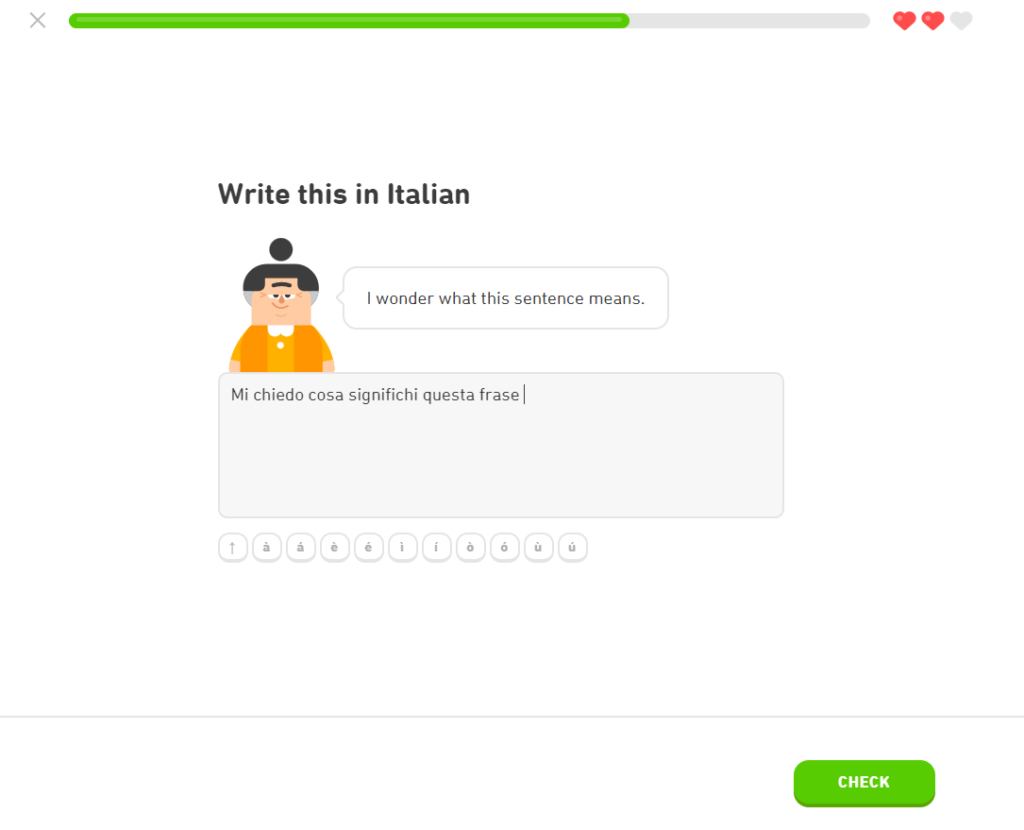
By focusing too much on the Italian subjunctive mood, there is a risk of discouraging the learner and making their learning experience too much of a memory exercise, with them having to memorize yet another tense.
- The preterite past tense (Duolingo section 4)
In today’s Italian, the preterite past tense is confined to written language, and found mainly in novels and essays. The Duolingo Italian course teaches this tense, although you won’t need it in spoken Italian. It is useful to understand that it exists, however, and to be able to understand it if you are planning on reading Italian literature.
The fact that Duolingo packs a lot of grammar in a short course can leave learners of Italian feeling discouraged and frustrated about learning, and can foster the belief that Italian as a foreign language is too difficult to master.
Can the Duolingo Italian course make me proficient?
When taken in isolation, some of the grammar topics dealt with in the Duolingo Italian course could be considered to be at level C1 and C2. They are highly complex topics and take time and practice to master. Examples are, the subjunctive mood, the preterite past tense, clitics and correct use of modal verbs.
Despite the density of grammar topics in Duolingo, it is unlikely that you will attain proficiency in Italian to genuine C1 or C2 level by completing the Duolingo Italian course alone, although Duolingo does give you a good general introduction to Italian, up to upper intermediate/ advanced level.
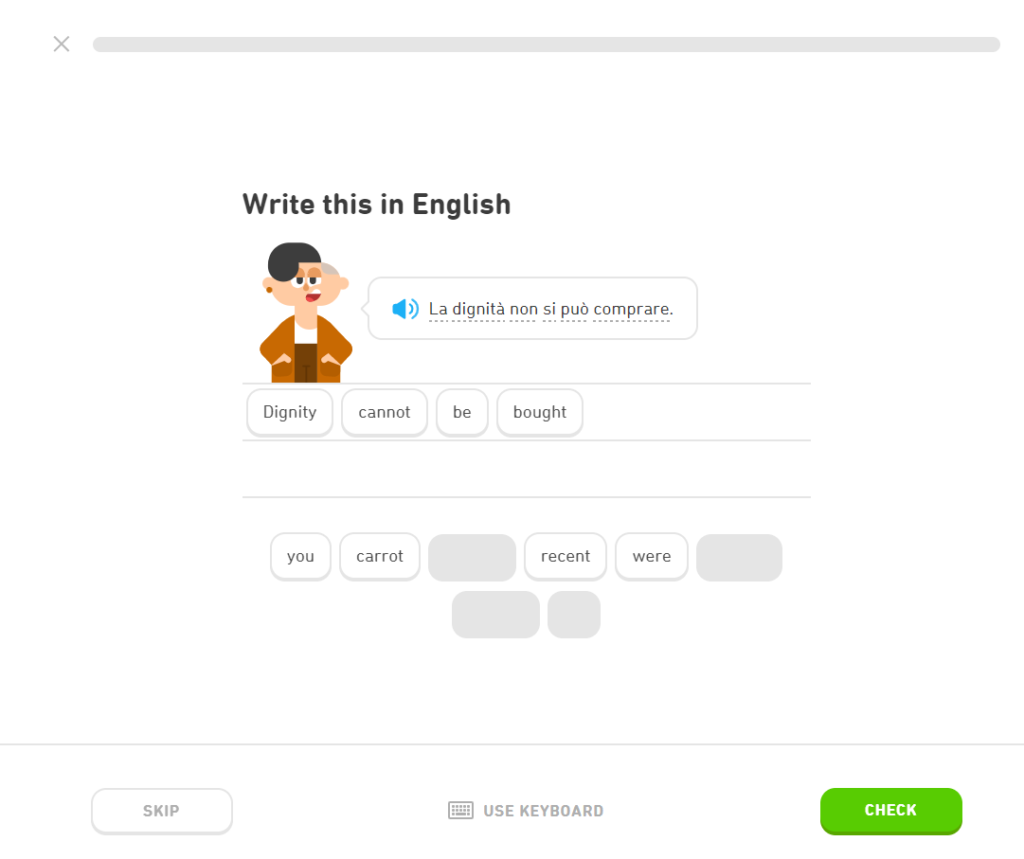
Which Italian tenses will I learn in Duolingo Italian?
The Duolingo Italian course teaches the following tenses …
- Present tense
- Present perfect
- Imperfect tense
- Past perfect
- Future tense
- Future perfect
- Preterite past
… and the following moods:
- Indicative
- Infinitive
- Gerund
- Conditional
- Subjunctive
Is the Duolingo Italian course suitable for beginners?
The Duolingo Italian course is suitable for beginners through to advanced learners so if have no background in Italian at all, Duolingo is a very good place to start.
Section 1 and Section 2 of the Duolingo Italian tree are at beginner level, progressing to intermediate / advanced in Sections 3 and 4. Duolingo will not allow you to progress to the higher levels unless you have completed the lower levels.
